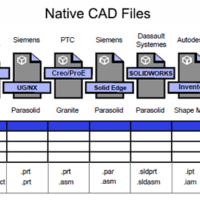
by Brad Strong | Sep 19, 2017 | Blog, CAD Translation, CAD Viewing, What's New |
The term ‘Digital Thread’ refers to a data and communications framework that passes through all relevant aspects of design, manufacturing, maintenance and disposal processes, providing an integrated and holistic view of assets throughout a product lifecycle. The Risk of Mixed Datums and Criteria Without a Digital Thread of product definition, manufactured parts might be designed with one set of datums and intents, manufactured using another set of datums and measurements, validated and checked using perhaps entirely new datums and criteria, and maintained with yet another set of systems and criteria. These criteria mismatches constitute a gap through which...

by Brad Strong | Sep 6, 2017 | Blog, CAD Repair, CAD Translation, Support, What's New |
The MagicHeal Add-On for TransMagic now includes a powerful set of tools that help you with detecting and correcting non-manifold geometry. This is important because failing to detect non-manifold geometry can lead to problems downstream, when you are trying to use that geometry in a CAD system that does not support non-manifold geometry. What does Non-Manifold mean? Manifold is a geometric topology term that means: To allow disjoint lumps to exist in a single logical body. Non-Manifold then means: All disjoint lumps must be their own logical body. See a more detailed description of non-manifold geometry in this article. Two Non-Manifold Tools Show...

by Brad Strong | Aug 28, 2017 | Blog, CAD Repair, CAD Translation, What's New |
What in the world is Repair By Color, and how could that possibly be useful? During Lite Repair, TransMagic attempts to stitch together surfaces that are near enough to one another to constitute an independent body; if two faces share the same plane, the error “Coincident Faces” can occur. The figure at right is one such example; running Lite Repair on this geometry will lead to the Coincident Faces error. This error is not uncommon since the CAD modeling process often designates the same plane for neighboring parts and bodies. This is possible because the environment is virtual and not real-world. In the real world, there is usually a slight...

by Brad Strong | Aug 24, 2017 | Blog, CAD Translation, Polygonal Output, What's New |
Being able to read and write a multitude of CAD and polygonal formats increases your flexibility as a company, and widens the range of companies you can deal with. TransMagic allows you to read and write native CAD formats (such as CATIA), geometric modeling kernel formats (such as Parasolid), neutral CAD formats (such as STEP), and polygonal formats (such as STL). Within each of those formats, TransMagic also gives you access to a wide range of versions. Here’s a summary of TransMagic’s supported formats: Native CAD Formats TransMagic can READ AutoCAD (.dwg, .dxf) CATIA (.model, .catpart, .catproduct) Creo (.prt, .asm) Inventor (.ipt, .iam)...







